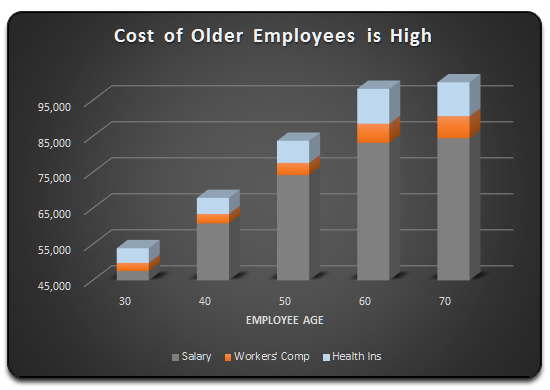Cost of Older Employees is High - Source of Future Earnings?
As fewer older employees retire the overall cost to enterprises increases - that is not a bad thing
 Companies are finding that overall salary budgets expand as more older employees chose to not retire. A number of factors are the driving forces of that. First most of the individuals in 60 plus age range are at the top of their salary ranges, and in many cases, way beyond that rate.
Companies are finding that overall salary budgets expand as more older employees chose to not retire. A number of factors are the driving forces of that. First most of the individuals in 60 plus age range are at the top of their salary ranges, and in many cases, way beyond that rate.
Younger employees, if they are promoted into those positions typically are paid at the lower end of the salary range.

The second factor is that insurance rating agencies look at the average age of an enterprises' employees when the set cost of various insurance policies.
There is the added complexity, that older employees are in a "protected" class an can not be discriminate against. If they do not "retire" there is not much that company can do unless they have a "strict" retirement enforcement policy.
Impact on Younger Employees
If the individuals at the top of the organization chart do not retire or "move-on", younger employees are not as upwardly mobile. In the case of Millennial, who typically do not have a long term plan to say with any one company, they will just move on. That will result in talent loss as well as increased expense due to recruiting and training costs.
Generational Change Key Management Issue
There have and will continue to be major demographic shifts in both the U.S. Labor Market and in IT professionals. Where the workforce in the 70's and 80's were interest in long term careers and as a result tended to work at the same company for a several years. The workforce of the early 21st century are interested in learning and brocading the scope of their knowledge. They think nothing of working for a company for one or two years and moving on.
At the same time the typical new employees look at positions as jobs and will focus on 9 to 5 and WFH, not till the job is completed as the workforce of the 2000 to 2010. That raises some very interesting staffing dilemmas that CIO and HR executives in IT organizations face. If they overstaffed costs will be too high, if they have higher attrition rates then training cost will increase and productivity will go down.
The key is retention of staff that is motivated to help the organization succeed.
Order IT Job Description HandiGuide Sample Description Download TOC



